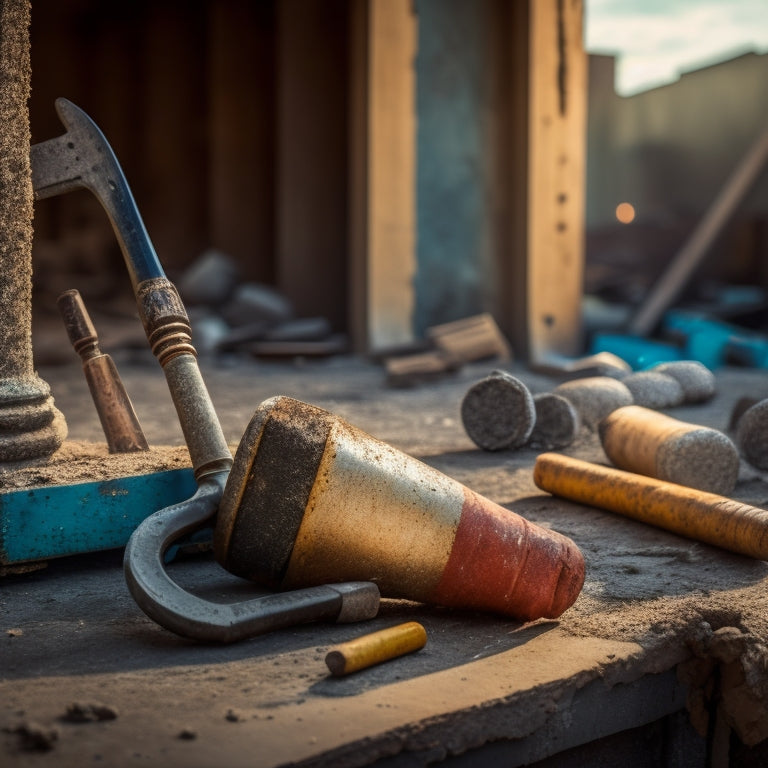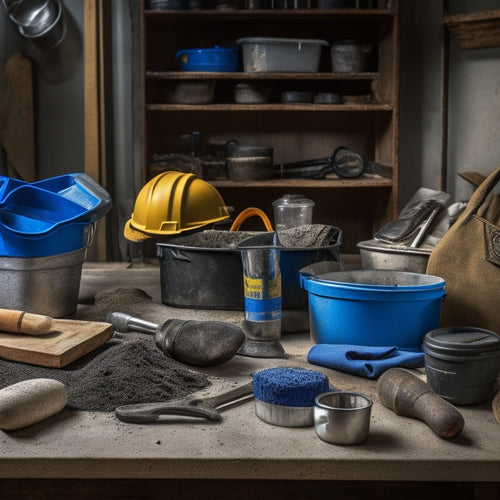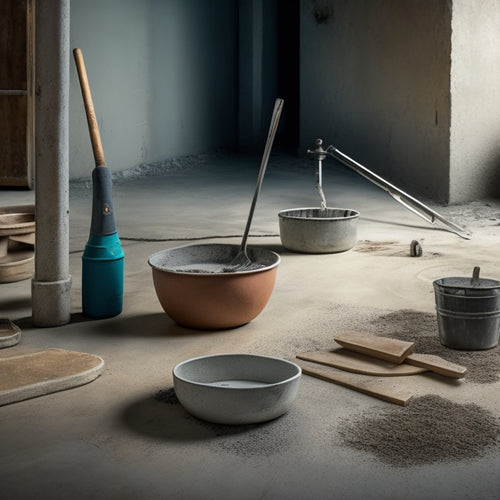
5 Tips for Splitting Concrete With Second-Hand Tools
Share
When splitting concrete with second-hand tools, you'll need to be strategic to avoid wasting time, money, and putting yourself at risk. First, inspect your tools for signs of wear, and consider certifications or guarantees that confirm industry standards. Choose the right wrench for the job, as the wrong one can lead to frequent repairs. Always prioritize safety by wearing protective gear and clearing your workspace of debris. Effective techniques like scoring and breaking or wedge and splitting can make the process easier, and regular tool maintenance will prolong the life of your equipment. By following these tips, you'll be well on your way to successfully splitting concrete - and there's more to learn about mastering this process.
Key Takeaways
- Inspect second-hand tools for signs of wear, rust, and broken parts before buying to ensure they're suitable for concrete splitting.
- Choose the right wrench for the job, considering factors like torque, versatility, and durability to avoid frequent repairs.
- Always wear personal protective gear, including safety glasses, gloves, and a dust mask, when splitting concrete to prevent injuries.
- Use effective block splitting techniques, such as scoring and breaking, or wedge and split, to minimize effort and maximize results.
- Regularly clean and maintain second-hand tools to prevent concrete residue buildup and prolong their lifespan.
Inspect Before You Buy
Before you bring that concrete splitter home, make certain you've given it a thorough once-over. You're about to invest time and money into this tool, so it's vital to confirm it's in good condition. Check for any signs of wear and tear, such as rust, dents, or broken parts. A high-quality tool will last longer and perform better, saving you time and effort in the long run.
When inspecting the tool, consider your budget considerations. You may be tempted to opt for a cheaper option, but remember that you get what you pay for. A low-quality tool may break easily, requiring frequent repairs or replacements, which can be costly in the long run. Instead, invest in a tool that's built to last, even if it means spending a bit more upfront.
Additionally, look for any certifications or guarantees that confirm the tool meets industry standards. A reputable manufacturer will stand behind their product, offering a warranty or guarantee that gives you peace of mind.
Choose the Right Wrench
Pick up the right wrench to tackle the task at hand. When it comes to splitting concrete, having the correct wrench is essential. You'll need a wrench that can handle the force and torque required to break through the concrete.
There are several wrench types to evaluate, each with its own strengths and weaknesses. Here are some factors to keep in mind when selecting a wrench:
-
Adjustable wrenches offer versatility, but may not provide the same level of torque as fixed wrenches.
-
Pipe wrenches are ideal for gripping and twisting, but may not be suitable for smaller bolts.
-
Socket wrenches provide a high level of torque, but may be bulkier than other options.
-
Ratchet wrenches offer ease of use and versatility, but may not be as durable as other options.
-
Torque wrenches provide precise control over the amount of torque applied, but may be more expensive than other options.
Proper size selection is also important. Choose a wrench that fits comfortably in your hand and can accommodate the size of the bolts or nuts you'll be working with.
With the right wrench in hand, you'll be well-equipped to tackle the task of splitting concrete.
Safety Precautions for Splitting
You're about to apply significant force to break apart concrete, so it's crucial you take necessary safety precautions to avoid injuries and damage.
Wearing personal protective gear is a must, including safety glasses, gloves, and a dust mask. Make certain your work area is clear of debris and obstacles to prevent tripping or falling. Guarantee good ventilation to avoid inhaling concrete dust, which can be hazardous to your health.
Designate a safe zone around your work area to prevent bystanders from getting hurt. Use warning signs or barriers to keep people at a safe distance. Keep a first-aid kit nearby in case of accidents.
Remove any loose clothing or jewelry that could get caught in your tools or concrete. Finally, stay focused and avoid distractions while splitting concrete to maintain control and avoid accidents.
Effective Block Splitting Techniques
Concrete block splitting requires a strategic approach to achieve clean breaks and avoid wasting material.
You'll need to evaluate the type of concrete, its strength, and the tools you're using to split it.
To split blocks effectively, follow these techniques:
-
Score and break: Use a concrete splitting tool to score the block along the desired break line. Then, use a hammer and chisel to break the block along the scored line.
-
Wedge and split: Drive a wedge into the block, using a hammer and chisel to create a crack. Continue to drive the wedge until the block splits.
-
Pry and break: Use a pry bar to apply pressure to the block, slowly prying it apart. This method is best for smaller blocks.
-
Drill and split: Drill holes along the desired break line, then use a chisel to split the block.
-
Split and re-split: If you're dealing with a large block, split it into smaller sections, then re-split those sections into individual pieces.
Tool Maintenance and Upkeep
Regularly, your concrete splitting tools take a beating, especially when working with stubborn blocks. To keep them in prime condition, you need to prioritize tool maintenance and upkeep. This will not only extend the life of your tools but also guarantee they continue to perform at their best.
Tool Maintenance Checklist
| Tool | Maintenance Task | Frequency |
|---|---|---|
| Wrecking bar | Clean with wire brush, apply rust inhibitor | After each use |
| Chisel set | Sharpen, clean, and oil | Weekly |
| Demolition hammer | Check and replace worn seals, clean | Monthly |
| Safety gloves | Inspect for damage, clean and condition | Daily |
You should also make it a habit to clean your tools after each use to prevent concrete residue from hardening. Regular tool cleaning and rust prevention will go a long way in maintaining the quality of your tools. By following this maintenance checklist, you'll be able to get the most out of your second-hand tools and guarantee they remain reliable for your concrete splitting projects.
Frequently Asked Questions
Can I Use a Sledgehammer to Split Concrete Blocks?
You can use a sledgehammer to split concrete blocks, but be sure to employ proper techniques, like striking the block's center, and prioritize safety by wearing protective gear and standing at a safe distance to avoid injury.
Is It Possible to Rent Concrete Splitting Tools?
It's not a coincidence you're considering renting concrete splitting tools - it's a smart move! You'll find various rental tool options offering advanced concrete splitting techniques, making the job easier and more efficient, so research and compare prices to find the best fit for your project.
How Do I Dispose of Broken Concrete Blocks?
You'll need to dispose of broken concrete blocks responsibly; consider concrete recycling or repurposing them for future projects. For block disposal, contact local waste management or construction companies that accept concrete debris, and follow their guidelines for proper drop-off or pickup.
Can I Resell My Used Concrete Splitting Tools?
You can resell your used concrete splitting tools if you've maintained them well, as good tool maintenance enhances resale value; clean, lubricate, and store them properly to attract buyers willing to pay a decent price.
Are There Any Local Regulations for Splitting Concrete on Residential Properties?
You'll want to "dig in" to local guidelines before splitting concrete on your residential property, ensuring you're aware of noise ordinances and safety precautions to avoid any, ahem, "cracks" in your plans or fines from the city.
Conclusion
You've made it through the trenches of splitting concrete with second-hand tools - and lived to tell the tale! With these 5 tips, you've conquered the impossible: taming the beast of broken concrete. Your tools may not be shiny and new, but with the right know-how, they're just as deadly. Now, go forth and shatter concrete like it's going out of style - and remember, a well-maintained tool is a happy tool!
Related Posts
-

Must-Have Tools for Laying Concrete Tiles
When laying concrete tiles, you'll need a range of essential tools to get the job done right. Start with subfloor pre...
-

5 Tools Needed for Quick Fix Concrete Mixing
You'll need five essential tools to tackle a quick fix concrete mixing project efficiently. First, you'll require a s...
-

Why You Need These Concrete Overlay Tools
When tackling a concrete overlay project, you need the right tools to achieve a flawless finish and avoid costly mist...


